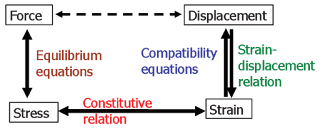Engineering mechanics is an important analytic; tool allows an engineer to optimize a
design, creating one that it is strong and rigid enough to do the job,but not overly heavy and expensive. A thorough study of mechanics some knowledge of calculus and vectors mechanics is an essential component of many engineering discipline,including mechanical aerospace and civil engineering. the purpose of this chapters is to provide introductory engineering students with some important, basic analysis tools that can be applied many design project.
Virtually any physical device in the "real world" is acted on by forces,which can include gravitational, pressure, magnetic, electrostatic, centrifugal and impact forces.Engineering mechanics studies that effects that forces have on materials, allowing engineers to theorize how to be fore it is build. Engineers may then optimize design on paper(or with a computer),without having to built faster and and more cost effectively.
This chapter has four major topics: In statics, the first step in analyzing many physical structures, assumption are made that all bodies are completely rigid and that they are strong enough to withstand the forces applied. Mechanics of materials considers how forces act upon actual bodies in bending, twisting or breaking them (of course, the goal of the designer is to create design that do not bend too much or break). Engineer use various design criteria to create use physical products, including design for strength, factor of safety and design for stiffness. Finlay, units are commonly used in mechanics are presented.
Know more about Engineering Mechanics, free download this book- click here
design, creating one that it is strong and rigid enough to do the job,but not overly heavy and expensive. A thorough study of mechanics some knowledge of calculus and vectors mechanics is an essential component of many engineering discipline,including mechanical aerospace and civil engineering. the purpose of this chapters is to provide introductory engineering students with some important, basic analysis tools that can be applied many design project.
Virtually any physical device in the "real world" is acted on by forces,which can include gravitational, pressure, magnetic, electrostatic, centrifugal and impact forces.Engineering mechanics studies that effects that forces have on materials, allowing engineers to theorize how to be fore it is build. Engineers may then optimize design on paper(or with a computer),without having to built faster and and more cost effectively.
This chapter has four major topics: In statics, the first step in analyzing many physical structures, assumption are made that all bodies are completely rigid and that they are strong enough to withstand the forces applied. Mechanics of materials considers how forces act upon actual bodies in bending, twisting or breaking them (of course, the goal of the designer is to create design that do not bend too much or break). Engineer use various design criteria to create use physical products, including design for strength, factor of safety and design for stiffness. Finlay, units are commonly used in mechanics are presented.
Know more about Engineering Mechanics, free download this book- click here





0 comments:
Post a Comment